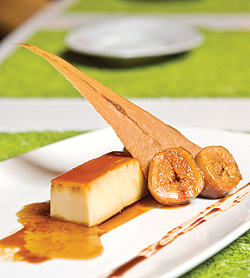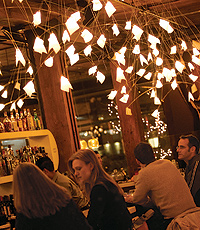by Dennis Ray Wheaton

At DeLaCosta the cream cheese flan and roasted figs soak up a Pedro Ximénez reduction for a spiked dessert. |
Let’s see: Popular Latino food. Small plates. A stylish atmosphere that is as much lounge as restaurant. Any new restaurants out there match this description? Oh, I almost forgot: that would be just about every new restaurant opened hereabouts in the past year or so. But two in particular-DeLaCosta in the River East Art Center and Zocalo in River North-have cashed in on combining the hottest trends in town.
Foodies went gaga over Douglas Rodriguez’s Patria in New York in the nineties, and now he’s brought the Nuevo Latino formula to Chicago. It’s a savvy move. The style has been hotter than chili peppers as of late-just consider Jerry Kleiner’s Carnivale, whose chef, Mark Mendez, is a Rodriguez protégé, and whose blaring colors may have been the inspiration for DeLaCosta’s wild décor. DeLaCosta, though, designed by Suhail (Del Toro), feels less Latino than 1960s-hippie-pad on a grand scale, cluttered with multicolored hanging fabrics, harlequin motifs, and light fixtures evoking giant sea urchins. There’s a sushi bar–style seviche counter and open kitchen behind smoky glass, as well as a huge central bar-not to mention the solarium along the river that sports four cabanas, each with its own bar and bartender.
Befitting a place that’s as much lounge as restaurant (with the noise to prove it), the first two pages of the menu are devoted to trendy libations, divided into classic cocktails, sangrías and poptails (fruity martinis with a homemade popsicle garnish), and muddled drinks like caipirinhas. Oh, and they also have Snow Queen vodka from Kazakhstan-you know, in case Borat drops by. I favor the wine list, where I found an apt Spanish 2000 red Montecello Reserva ($50). Warm, little soft cassava flour rolls, stuffed with queso blanco, serve as free nibbles to soak it all up.

Fixtures suggesting a school of fish throw light on the bar scene at DeLaCosta. |
Chef de cuisine Adam Schop oversees Rodriguez’s tempting menu. Nuevo Latino may be more popular than it is cutting edge, but under Schop’s guidance, it can be exhilarating in its own right. A good opening salvo is a trio of made-to-order seviches-choose from among ten bright-flavored Peruvian tiradito and Ecuadorian mixto styles. I especially liked the spiral-cut scallop tiradito flavored with tomatillo marmalade and shiso and accompanied by a crunchy counterpoint of Espelette popcorn (coated with chili and salt), and the Ecuadorian white shrimp with charred tomato sauce, avocado, cilantro, and a side of corn nuts. I also threw in a chewy-good short-rib flatbread with creamed leeks and jalapeño escabeche. Another smart choice.
My vote for most unusual morsels at DeLaCosta goes to the boquerones pintxo, a Basque-inspired appetizer of pungent sardines tightly wrapped around the end of bread sticks with Spanish olives and chili threads. Rodriguez once believed that only New Yorkers ordered sardines, but now he’s betting that we’ll also love this delicacy. He can count me in. Oysters Rodriguez is a sly play on oysters Rockefeller-deep-fried mollusks on the half shell over fufu (spinach purée, plaintain, and cream) and horseradish cream with bits of apple-wood-smoked bacon and a zing from huacatay (Peruvian black mint) sauce. Not as rich as a Rockefeller, maybe, but in the same neighborhood.
I’m not sure how many in DeLaCosta’s scenester crowd bother to move beyond small plates to main courses. They should: they’d probably enjoy the Uruguayan churrasco tenderloin with tomato-thyme chimichurri, the crisp-skinned sautéed crackling pork with kumquat mojo and black-bean purée, or the scallops wrapped in serrano ham with one whole Alaskan king crab leg, saffron rice, and avocado salad drizzled with piquillo vinaigrette. But if they see the xim xim of mushy prawns with dry coconut-braised chicken breast, cashews, and bacon-wrapped bananas, they should run the other way.
Anyone with a sweet tooth and a sense of humor would get a kick out of the chocolate mousse cigar with a cookie-candy matchbook, Cognac sauce, and dark chocolate sorbet. Yes, you can eat the ashes. The warm chocolate tres leches isn’t exactly traditional, but it’s a cozy cold-weather treat. Service, on the other hand, is all over the place, ranging from one guy who seemed to have clocked in to the wrong restaurant, to a waitress just wonderfully helpful and engaging. But no one seems to mind one way or the other. DeLaCosta delivers the festive flash that patrons are clamoring for.
Cousins Marcos and Edgar Castaneda (the latter a son of Lalo’s founder) wasted no time in retooling the sprawling former Chilpancingo into a more modern space for Zocalo, their small plates/big drinks palace. The festive folk art décor is out; exposed wood and local artwork is in. The place looks sophisticated and bright but, compared with DeLaCosta, it’s practically subdued. Zocalo’s patrons, however, are anything but restrained. They jam the room and methodically work their way through the excellent house margaritas made with Herradura-just one of many Latino cocktails that vie for attention with fun tequila flights.
In the kitchen is Saul Roman, who trained in Mexico and has worked at ¡Salpicón! and Adobo Grill. His team must spend a lot of time churning out crowd-pleasing guacamole trio appetizers. The triple treat comes on one platter: a traditional version, a rojo guac made with roasted tomatoes and red jalapeños, and a fruit concoction of papaya, guava, and walnuts. My companions thought the classic was the best, though I was partial to the spicier rojo; the fruit and nut one was strictly for those who walk on the mild side. And there are all sorts of chips to mix and match and practice your dipping techniques-crunchy fresh boniato (think sweet-potato chips), plantain, malanga (similar to taro root), and tortilla.
(ON WINE)
At Latino restaurants, I’m always torn between ordering a Spanish or a South American wine, since both are naturals with the cuisine. Same deal at home, where I often whip up Mexican fare for dinner. Spain, however, has won my heart lately with a spate of successful reds exhibiting hearty, rich flavors perfect for robust spicy chow. While some reach pricey French Bordeaux levels, many recent Spanish reds offer high-quality values that make them sensible buys. I was most infatuated with the 2003 Bodegas Castaño Hécula Yecla ($10), but the 2005 Agapito Rico Carchelo Jumilla Monastrell ($6), the 2004 Ercavio Tempranillo Robla Tierra de Castilla ($10), and the 2004 bcabernet sauvignon–tempranillo blend ($9) also pepped up the carne asada.
–D. R. W. |
Seviches are a big deal here, too; among seven lively combinations, my main squeeze was the tuna mixed with mango and avocado in a raw tomatillo-poblano broth. Trios are a theme at both these restaurants, so you might as well go with the flow and try the tamalitos: miniature fresh corn tamales of marinated chicken and mole negro wrapped in a banana leaf, jalapeños with four cheeses, and black beans and molcate sauce topped with crumbly requeson cheese. Fun, but a little bland despite their components, and they reinforced my growing concern that the kitchen waters down some of Zocalo’s food for River North palates. My skepticism grew when I tried the albondigas (meatballs) in chipotle sauce. On one visit the brothy sauce was thin and hardly tasted of the smoky chipotle; next time not only did the broth disappoint, the meatballs managed to remain dry. But the fish tacos-tilapia and a salsa of poblano chilies in warm blue-corn tortillas-restored my faith in the chef. These babies tasted like real Mexican seaside food.
Zocalo’s carne asada is a tequila-marinated skirt steak with refried black beans and creamy roasted poblanos and onions. The tasty meat is topped with very macho green salsa macha (here a spicy blend of chilies, garlic, cilantro, and lime juice)-one bite and I had smoke coming out of my ears. So much for calling everything underseasoned. In a homier vein, I also liked the grilled Cornish hen in a mango glaze with a homey white rice and black beans mix, all topped with skinny strips of fried breaded onion. Enchiladas del campo sounded interesting but the two folded masa crèpes filled with corn fungus and awash in a poblano cream sauce again lacked oomph. I was jazzed far more by the ancho- and guajillo-chile–rubbed whole snapper split and topped with an escabeche of thinly sliced marinated vegetables with jalapeños. A spicy 2004 Catena Argentine malbec ($55) did these dishes justice.
My favorite desserts were the luscious ate con queso-candied quince on a chocolate marbled cheesecake-and the capirotada, raisin walnut bread pudding with cajeta (goat’s-milk caramel) ice cream. “Zócalo” is the Mexican word for a town square, a central place for socializing; Zocalo the restaurant has some problems that can make it as wobbly as our table was one visit, but the atmosphere, the drinks, and most of the food make it a congenial place to gather.
DE LA COSTA–465 East Illinois Street; www.delacostachicago.com. Appetizers $9 to $14, entrées $21 to $32, desserts $7 to $9. Lunch Monday to Friday, dinner nightly. Reservations: 312-464-1700.
ZOCALO–358 West Ontario Street; www.zocalochicago.com. Appetizers $6 to $10, entrées $14 to $23, desserts $4 to $5. Lunch Monday to Friday, dinner nightly. Reservations: 312-302-9977.
|